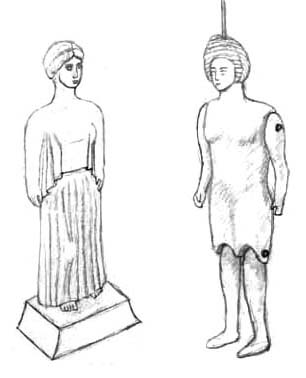In the middle of the century, terracottas influenced from marble sculpture were plentifully produced. Most characteristic figure is a woman in peplos, standing(fig.6) or sitting. Her hair is parted down the middle and dressed in a diadem or a snood called sakkos. This Severe style soon fell out of favour in sculpture, but its influence on terracottas was longer-lived. Terracottas made in Boeotia about 430 B.C. have an unique character. This female figure wares a low polos surmounting a bulky and highly elaborate arrangement of the hair, sometimes looks strange. In the fourth century, instead of these Severe styled figures, made by two moulds, more complex postured figures were produced with the help of five or more moulds. These are forerunners of Hellenistic terracottas. Other than these, a quantity of Terracottas represented comedy actors were made in Athens. They wear comical or grotesque masks and protrude their belly. These features were favoured till Roman period. In the middle of the fourth century, figurines made as toy were in fashion(fig.7). The body and the limb were made separately, and joined by string in order to be movable. In the head, there is a hole to suspend.
 |